
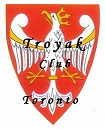
TROYAK EXECUTIVE TEAM is informing all members, colleagues, collectors, and Polonia at large, that Club meetings taking place at John Paul II Polish Cultural Centre, 4300 Cawthra Rd. (just south of Hwy. 403), Mississauga, Ontario. The new members are always welcome. www.polishculturalcentre.ca
ADRES SPOTKAÑ KLUBOWYCH ! Zarząd Główny Klubu “Troyak” informuje wszystkich członków kolekcjonerów, sympatyków oraz całą Polonię, że spotkania klubowe odbywają się w Polskim Centrum Kultury im. Jana Pawła II, przy 4300 Cawthra Rd. (na południe od autostrady 403), Mississauga, Ontario. Zapraszamy nowych członków do prężnego. Klubu “Troyak”. www.polishculturalcentre.ca

“TROYAK” CLUB NEXT MEETINGS …
NASTĘPNE SPOTKANIA KLUBU “TROYAK” …
26th February 2023 @ 4:30 p.m.

Sunday – 5th March 2023 @ 9:00 a.m. to 4:00 p.m.
Mississauga Coin & Stamp Show
26th March 2023
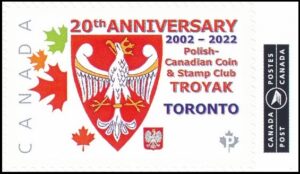
30th April 2023
28th May 2023; 25th June 2023
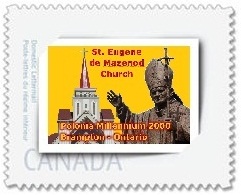
July & August 2023 – Summer break … Letnie wakacje …

TROYAK CLUB @ Roncesvalles Polish Festival 2023
Saturday, September 16th & Sunday, September 17th, 2023
https://polishfestival.ca www.kazimierz.org
St. Casimir’s Church
Parish Hall … 156 Roncesvalles Ave. Toronto, Ontario
Stamp Exhibit … Pope John Paul II on World Stamps and
Displays of Coins, Stamps, Collectibles by Troyak Club Members.
Roncesvalles Polish Festival
www.troyakclub.com

30th September 2023
29th October 2023
26th November 2023
December 2023 … Happy Holidays!


40-lecie wydobycia Lubelskiego Węgla Bogdanka S.A.
www.poczta-polska.pl
W dniu 30 listopada 2022 r. została wprowadzona do obiegu kartka pocztowa z nadrukowanym znakiem opłaty pocztowej, emisji: 40-lecie wydobycia Lubelskiego Węgla “Bogdanka” S.A. Wartość nominalna znaku opłaty pocztowej z oznaczeniem literowym A odpowiada wartości nominalnej znaczka pocztowego używanego do uiszczenia opłaty za ekonomiczną przesyłkę listową nierejestrowaną, w tym kartkę pocztową, w obrocie krajowym, w formacie S o masie do 500 g.

Na kartce przedstawiono kopalnię węgla kamiennego “Bogdanka” – w polu znaczkowym na fotografii archiwalnej, natomiast w części ilustracyjnej na współczesnym zdjęciu. Kartkę o wymiarach 148 x 105 mm wydrukowano jednostronnie, techniką offsetową, na kartonie białym, w nakładzie 8 000 sztuk. Autorka projektu kartki: Beata Brzyńska-Rogala.

Grigol Peradze
www.poczta-polska.pl

W dniu 6 grudnia 2022 roku został wprowadzony do obiegu znaczek pocztowy o wartości 3,90 zł każdy, emisji “Grigol Peradze”. Na znaczku przedstawiono wizerunek gruzińskiego duchownego Grigola Peradze na tle bramy Uniwersytetu Warszawskiego, w oparciu o archiwalną fotografię oraz faksymile podpisu Grigola Peradze w języku gruzińskim. W górnym, prawym rogu umieszczono oznaczenie nominału 3,90 zł.Wzdłuż lewej krawędzi umieszczono napisy: POLSKA i Grigol Peradze 1899-1942.
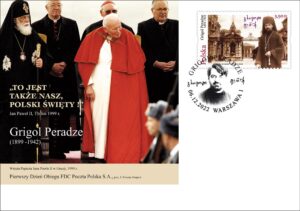
Znaczki wydrukowano techniką offsetową, na papierze fluorescencyjnym, w formacie 51mm x 31,25 mm, w nakładzie 128 000 sztuk. Arkusz sprzedażny zawiera 8 sztuk znaczków. Z tej okazji została wydana koperta FDC. Autor projektu: David Kolbaia.

Polska w kosmosie
www.poczta-polska.pl
W dniu 6 grudnia 2022 r. zostały wprowadzone do obiegu cztery znaczki pocztowe w formie bloku o wartości 3,90 zł każdy, emisji “Polska w kosmosie”. Na poszczególnych znaczkach przedstawiono: na pierwszym – EarthCARE czyli misję obserwacji Ziemi; na drugim – misję BRITE; na trzecim – misję naukową Proba – 3; na czwartym – misję OPS-SAT. Znaczki wydrukowano techniką offsetową, na papierze fluorescencyjnym, w formacie 31,25 x 43 mm , w nakładzie 100 000 sztuk. Z tej okazji zostały wydane również dwie koperty FDC. Autor projektu znaczka: Roch Stefaniak.
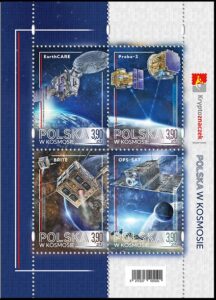
Emisja pierwszych polskich kryptoznaczków „Polska w kosmosie” jest zaplanowana na I kwartał 2023 roku, ale już 6 grudnia br. pojawiła się ona w wersji tradycyjnej. Autorem projektów wszystkich znaczków, przygotowanych na podstawie grafik Bartosza Morawskiego, jest Roch Stefaniak. Emisja liczy cztery znaczki – każdy z nich poświęcony jest misjom w ramach projektów międzynarodowych, w których wkład mieli polscy naukowcy.

*** Pierwszy znaczek dotyczy EarthCARE – misji obserwacji Ziemi, organizowanej przez Europejską Agencję Kosmiczną (ESA) we współpracy z Japońską Agencją Kosmiczną (JAXA) i japońskim Krajowym Instytutem Technologii Informacyjno-Komunikacyjnych (NICT). *** Na drugim znaczku pokazano satelity: Lem (wystartował 21 listopada 2013 r.) oraz Heweliusz (wystartował 19 sierpnia 2014 r.) Misja BRITE-PL jest częścią projektu kanadyjsko-austriacko-polskiego. *** Trzeci znaczek poświęcono programowi Europejskiej Agencji Kosmicznej PROBA. Demonstruje technologie platform satelitarnych i ładunków użytecznych. *** Na czwartym znaczku widnieją elementy kosmiczne OPS-SAT, która jest pierwszą misją Europejskiego Centrum Operacji Satelitarnych (ESOC), wykonywaną na satelicie typu CubeSat. Jej głównym celem jest testowanie nowych standardów wymiany danych pomiędzy satelitą a segmentem naziemnym. Polscy eksperci odpowiedzialni są za opracowanie całego oprogramowania pokładowego misji, systemów kontrolnych i wykrywania awarii, za realizację nowego standardu wymiany danych oraz za jeden z dwóch kluczowych ładunków OPS-SAT – konwerter protokołów CCSDS. Start tej misji miał miejsce w grudniu 2019 roku.
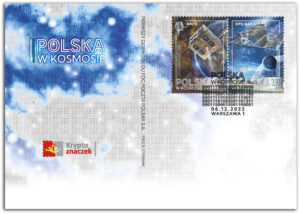
Grafiki wykorzystane w wersji tradycyjnej znaczków, pojawią się również na kryptoznaczkach, mających trafić do sprzedaży w pierwszym kwartale 2023 r. Każdy kryptoznaczek składa się z dwóch części: jedna to tradycyjny znaczek pocztowy, a druga – przez unikatowe tokeny NFT na sieci Polygon w standardzie ERC1155, który umożliwia obsługę wielu typów tokenów w ramach jednej aplikacji w środowisku blockchain. System Polskiego kryptoznaczka to nie tylko połączenie tradycyjnych znaczków pocztowych i technologii kryptograficznych, ale również kompletne środowisko budujące cyfrową społeczność filatelistyczną w Polsce i na świecie. Autorem utworzenia i wdrożenia koncepcji kolekcji kryptoznaczka jest Dariusz Tyszka. Partnerami emisji są: Polska Agencja Kosmiczna oraz Polska Wytwórnia Papierów Wartościowych.

Niemiecki obóz dla polskich dzieci w Łodzi (1942-1945)
www.poczta-polska.pl
W dniu 8 grudnia 2022 roku został wprowadzony do obiegu znaczek pocztowy o wartości 3,90 zł emisji “Niemiecki obóz dla polskich dzieci w Łodzi (1942-1945)”. Na znaczku przedstawiono dwie dziecięce postacie za drutem kolczastym, symbolizujące dramat uwięzienia i cierpienia w niewoli. Znaczki wydrukowano techniką offsetową, na papierze fluorescencyjnym, w formacie 31,25 x 43 mm, w nakładzie 144 000 sztuk. Arkusz sprzedażny zawiera 12 sztuk znaczków. Autor projektu: Jan Konarzewski.
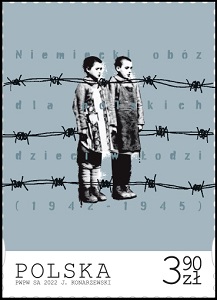
Ponad 80 lat temu Niemcy utworzyli obóz koncentracyjny dla dzieci i młodzieży przy ulicy Przemysłowej w Łodzi. W miejscu kaźni, stworzonym przez okupanta, katorżniczą pracę na rzecz niemieckiej machiny wojennej i przemysłu wykonywały najmłodsze ofiary II wojny światowej. W bieżącym roku przypada 78. rocznica zakończenia funkcjonowania niemieckiego obozu koncentracyjnego dla polskich dzieci. Główne uroczystości miały miejsce 17 stycznia w łódzkim „Muzeum Dzieci Polskich – ofiar totalitaryzmu”. Jednym z elementów obchodów rocznicy była prezentacja znaczka pocztowego oraz koperty pierwszego dnia obiegu FDC emisji „Niemiecki obóz dla polskich dzieci w Łodzi (1942–1945)”. Wśród uczestników wydarzenia znaleźli się m.in. wiceprezes Rady Ministrów i Minister Kultury i Dziedzictwa Narodowego prof. Piotr Gliński, rzecznik Praw Dziecka Mikołaj Pawlak, dyrektor Muzeum Dzieci Polskich – ofiar totalitaryzmu dr Ireneusz Piotr Maj, dr hab. Dariusz Rogut – dyrektor łódzkiego oddziału Instytutu Pamięci Narodowej oraz Wiesław Włodek – wiceprezes Poczty Polskiej.

– Emisje filatelistyczne Poczty to częstokroć namiastka lekcji historii dla kolejnych pokoleń Polaków, a udział w projektach promujących wiedzę o losach naszej Ojczyzny, ważnych wydarzeniach i postaciach, traktujemy jako społeczny obowiązek. Znaczek oraz kartka upamiętniające najmłodsze ofiary II Wojny Światowej wpisują się w misję Spółki. Poczta to instytucja nierozerwalnie związana z dziejami Polski, dlatego jesteśmy zdeterminowani, by poprzez nasze emisje filatelistyczne budować i promować narodową pamięć historyczną – powiedział Wiesław Włodek, wiceprezes Poczty Polskiej.
Projekt znaczka pocztowego emisji „Niemiecki obóz dla polskich dzieci w Łodzi (1942–1945)” przedstawia dwie monochromatyczne dziecięce sylwetki, stojące za drutem kolczastym, symbolizującym tragiczny los i cierpienie w obozowej niewoli.
Poczta Polska angażuje się w wartościowe projekty historyczne. Wiele z nich inicjuje samodzielnie, współpracując z uznanymi historykami lub instytucjami naukowymi. Celem inicjatyw jest rzetelny i wartościowy przekaz, który przyczynia się do rozwijania powszechnej wiedzy o narodowych Bohaterach oraz wydarzeniach, które ukształtowały tożsamość Polski.
Warto przypomnieć, że 5 listopada ub.r. Poczta Polska otrzymała nagrodę złotego BohaterONaim. Powstańców Warszawskich w kategorii Firma. To wyjątkowe trofeum wyróżnia osoby i instytucje, których działania w szczególny sposób promują wiedzę o historii Polski XX wieku oraz edukację historyczno-patriotyczną.BohaterONy stanowią także uznanie za wcielanie w życie wartości, jakimi kierowali się Powstańcy Warszawscy.

Mikołów
www.poczta-polska.pl
W dniu 9 grudnia 2022 roku został wprowadzony do obiegu znaczek pocztowy o wartości 3,90 zł emisji “Mikołów”. To wyjątkowe wydawnictwo filatelistyczne wpisuje się w obchody 800-lecia istnienia jednego z najstarszych miast Śląska. Uroczystość prezentacji znaczka miała miejsce 9 grudnia w sali Marmurowej Śląskiego Urzędu Wojewódzkiego. Wydarzenie objął patronatem Jarosław Wieczorek – Wojewoda Śląski. Na znaczku przedstawiono neorenesansowy ratusz w Mikołowie, który położony jest przy zachodniej pierzei Rynku. W grafice koperty FDC autor emisji Adam Kultys zaprezentował fragment wnętrza bazyliki św. Wojciecha, w której znajdują się m.in. obrazy Męki Pańskiej Jana Bochenka z 1868 roku, XIX-wieczne witraże z tzw. szkoły krakowskiej oraz zabytkowe organy pochodzące z 1862 roku, wykonane przez Johanna Matthiasa Vinzenza Haasa. Grafika datownika to historyczny herb Mikołowa, który swoją symboliką nawiązuje do dawnych pieczęci miejskich z XV-XVIII w. Każda z nich posiada rysunek hełmu rycerskiego z opuszczoną przyłbicą i pękiem piór.

Wnioskodawcą emisji jest Pani Izabela Kloc, poseł do Parlamentu Europejskiego – Grupa EKR. Emisja powstała we współpracy z Urzędem Miasta w Mikołowie, skąd pochodzą materiały użyte w grafice znaczka i datownika. Natomiast zdjęcia użyte w grafice koperty FDC są autorstwa Pana Adama Kultysa, twórcy emisji. Znaczki wydrukowano techniką offsetową, na papierze fluorescencyjnym, w formacie 43 x 31,25 mm, w nakładzie 144 000 sztuk. Arkusz sprzedażny zawiera 12 sztuk znaczków. Autor projektu: Adam Kultys.
– Przez osiem wieków Mikołów uczestniczył w dziejowych przemianach, które ukształtowały obec-ny wizerunek Górnego Śląska. Miasto stało się istotnym ośrodkiem kultu religijnego – w 2008 roku Ojciec Święty Benedykt XVI wyniósł kościół św. Wojciecha do godności bazyliki mniejszej. W Miko-łowie powstała również pierwsza polska drukarnia na Śląsku, w której Karol Miarka drukował „Katolika”. Budząca świadomość narodową działalność wydawnicza mikołowskich drukarzy i ich aktywność społeczna miały duży wpływ na rozwój polskich stowarzyszeń oraz wyniki wyborów na Śląsku – w 1922 r. Mikołów wraz z częścią Górnego Śląska znalazł się w granicach II Rzeczypospolitej – powiedziała Izabela Kloc, Poseł do Parlamentu Europejskiego.
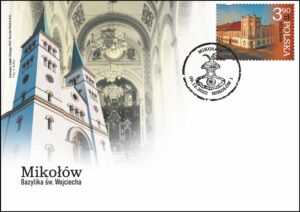
– Poczta Polska od wieków towarzyszy Polakom w ich najważniejszych momentach dziejowych. Honorujemy bohaterów narodowych, ludzi zasłużonych dla Ojczyzny, ale także przypominamy istotne wydarzenia, które miały wpływ na dzisiejszych obywateli Polski. Niewątpliwie jubileusz powstania miasta jest jednym z najważniejszych momentów dla lokalnej społeczności. Niewiele miast na Śląsku może poszczycić się 800-letnią historią. Świadkami dziejów są zabytki architektury miejskiej, które opowiadają o tradycjach, zaangażowaniu i oddaniu, jakim wykazały się pokolenia mikołowian w rozwój ich małej Ojczyzny. Nasz nowy znaczek jest swoistym podziękowaniem za trud ich pracy. Mam nadzieję, że przypadnie on do gustu wszystkim naszym klientom – stwierdził wiceprezes Wiesław Włodek.

Gabriel Narutowicz – pierwszy prezydent II RP
www.poczta-polska.pl
W dniu 11 grudnia 2022 r. został wprowadzony do obiegu znaczek pocztowy o wartości 3,90 zł emisji “Gabriel Narutowicz – pierwszy prezydent II RP”. Na znaczku przedstawiono wizerunek Gabriela Narutowicza na podstawie rys. Adama Grabowskiego.
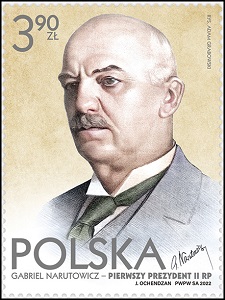
Na kopercie okolicznościowej zamieszczono kopię Protokołu z posiedzenia Zgromadzenia Narodowego z dn. 11.12.1922 r. powierzającego Gabrielowi Narutowiczowi urząd Prezydenta RP, zaś na datowniku okolicznościowym widnieje autograf Gabriela Narutowicza. Założeniem emisji jest uhonorowanie 100. rocznicy wyboru Gabriela Narutowicza na Prezydenta II RP.
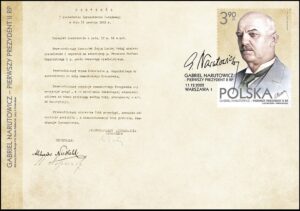
Wnioskodawcą emisji jest IPN i Ministerstwo Kultury, Dziedzictwa Narodowego i Sportu. Znaczek wydrukowano techniką rotograwiurową, na papierze fluorescencyjnym, format znaczka: 40,50 x 54 mm , w nakładzie 140.000 szt. Arkusz sprzedażny zawiera 35 szt. znaczków. Z tej okazji została wydana również koperta FDC. Autor projektu: Jarosław Ochendzan.

30-lecie nawiązania stosunków dyplomatycznych Polska-RPA
www.poczta-polska.pl
W dniu 14 grudnia 2022 r. została wprowadzona do obiegu kartka pocztowa z nadrukowanym znakiem opłaty pocztowej, emisji: “30-lecie nawiązania stosunków dyplomatycznych Polska-RPA”. Wartość nominalna znaku opłaty pocztowej z oznaczeniem literowym A odpowiada wartości nominalnej znaczka pocztowego używanego do uiszczenia opłaty za ekonomiczną przesyłkę listową nierejestrowaną, w tym kartkę pocztową, w obrocie krajowym, w formacie S o masie do 500 g.
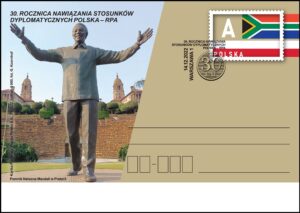
Na znaku opłaty z oznaczeniem wartości A (3,90 zł) umieszczono barwy narodowe Polski i RPA. W części ilustracyjnej kartki umieszczono wizerunek pomnika Neslona Mandeli w Pretorii. Kartkę o wymiarach 148 x 105 mm wydrukowano jednostronnie, techniką offsetową, na kartonie białym, w nakładzie 5 000 sztuk. Autor projektu kartki: Jan Konarzewski.

Kurierzy Sądeccy
www.poczta-polska.pl
Poczta Polska upamiętniła Kurierów Sądeckich, patronów Szkoły Podstawowej nr 17 na Porębie Małej, która obchodzi w tym roku 120-lecie istnienia. Przygotowana pocztówka przedstawia zdjęcia patronów tej historycznej placówki oświatowej, którzy służyli podczas II wojny światowej Polskiemu Państwu Podziemnemu.
Uroczysta prezentacja kartki pocztowej odbyła się 29 grudnia 2022 r. w Muzeum Okręgowym w Nowym Sączu. Zamysł emisji kartki polegał na upamiętnieniu wybranych patronów szkoły. Kartka jest adresowana do młodzieży, by nigdy nie zapomniała, dzięki komu kolejne pokolenia mogą żyć w wolnej Ojczyźnie. Obecny budynek szkoły został oddany do użytku w 1978 roku. Założona w 1840 r. w Zeleźnikowej placówka oświatowa była świadkiem wielu ważnych i nierzadko dramatycznych wydarzeń, w tym wojen światowych. Znajdowała się pod okupacjami różnych najeźdźców, a walki między nimi, jak choćby podczas sowiecko-niemieckich zmagań w trakcie II wojny światowej, spowodowały wiele zniszczeń.
Szkoła zyskała obecnych patronów w 1998 roku. I to właśnie oni stali się bohaterami grafiki emisji filatelistycznej. Zdjęcia patronujących szkole kurierów Polskiego Państwa Podziemnego: Jana Freislera, Romana Stramkę i Klemensa Gucwę, autor grafiki Błażej Targosz umieścił na tle cegieł muru obok ilustracji kamienia znajdującego się przed szkołą z ozdobnym napisem: KURIEROM SĄDECKIM MIEJSCOWYM W WALCE ZBROJNEJ. Po drugiej stronie widnieje w tle ilustracja elewacji szkoły, wyeksponowana tak delikatnie, że można na niej nanosić treść.
– Poczta Polska z przyjemnością przyjęła zaproszenie do udziału w tym wyjątkowym wydarzeniu upamiętniającym 120 lat historii Szkoły Podstawowej na Porębie Małej. Nasz wkład to wydanie historycznej kartki okolicznościowej, będącej swoistym hołdem dla lokalnej społeczności oraz patronów tej placówki oświatowej, czyli Kurierów Sądeckich. W dzisiejszych czasach powinniśmy w sposób szczególny czcić pamięć bohaterów walczących o wolność dla narodu i przyszłych pokoleń – powiedział Andrzej Bodziony, wiceprezes zarządu Poczty Polskiej.
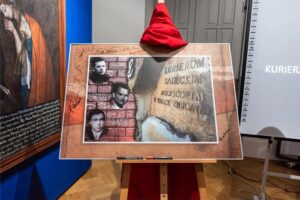
Jan Freisler „Ksawery” (1914–1964) to jeden z najwybitniejszych kurierów wojennych. Przeprowadzał ludzi i przekazywał przesyłki w realiach okupacji sowieckiej oraz niemieckiej. Działał też na szlaku do Budapesztu. W ostatnich miesiącach wojny walczył w partyzantce Armii Krajowej. W 1945 roku przedostał się na Zachód. Po odbyciu ostatniej misji jako kurier Oddziału Specjalnego Sztabu Naczelnego Wodza do kierownictwa poakowskiego podziemia w Polsce został aresztowany i skazany na karę śmierci. Po ułaskawieniu, 10 lat spędził w więzieniu.
Klemens Konstanty Gucwa był przedwojennym sportowcem i żołnierzem, a podczas wojny kurierem Polskiego Państwa Podziemnego. Poległ zastrzelony przez słowackich pograniczników w okolicach węgierskich wówczas Koszyc, w trakcie misji kurierskiej do Budapesztu. Był przyjacielem Jana Freislera z rodzinnego podwórka. Został odznaczony Krzyżem Virtuti Militari.
Roman Stramka był przewodnikiem i kurierem AK oraz placówki «W» w Budapeszcie przez „zieloną granicę”. Był świetnym narciarzem biegowym, wicemistrzem Polski z 1953 r. w biegu na 53 km., trenerem i instruktorem narciarstwa. Podczas wojny zasłynął z brawurowych ucieczek z rąk wroga, w tym z nowosądeckiego więzienia Gestapo. Za swoje zasługi został odznaczony Krzyżem Virtuti Militari.

Złamanie szyfru Enigmy
www.poczta-polska.pl
W dniu 30 grudnia 2022 r. została wprowadzona do obiegu kartka pocztowa z nadrukowanym znakiem opłaty pocztowej, emisji: “Złamanie szyfru Enigmy”. Wartość nominalna znaku opłaty pocztowej z oznaczeniem literowym A odpowiada wartości nominalnej znaczka pocztowego używanego do uiszczenia opłaty za ekonomiczną przesyłkę listową nierejestrowaną, w tym kartkę pocztową, w obrocie krajowym, w formacie S o masie do 500 g. Na znaku opłaty z oznaczeniem wartości A (3,90 zł) umieszczono fragment klawiatury maszyny szyfrującej.
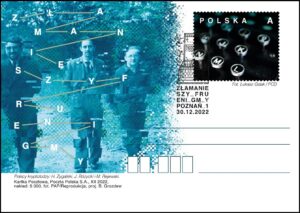
W części ilustracyjnej kartki przedstawione zostało cyfrowo zmodyfikowane zdjęcie trzech polskich kryptologów, którym udało się złamać szyfr Enigmy oraz napis: ZŁAMANIE SZYFRU ENIGMY. Kartkę o wymiarach 148 x 105 mm wydrukowano jednostronnie, techniką offsetową, na kartonie białym, w nakładzie 5 000 sztuk. Autor projektu kartki: Bożydar Grozdew.

Thorgal
www.poczta-polska.pl
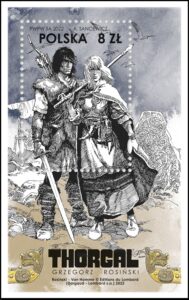
W dniu 31 grudnia 2022 r. został wprowadzony do obiegu znaczek pocztowy w formie bloku o wartości 8,00 zł, emisji “Thorgal”. Na znaczku, kopercie FDC i datowniku FDC przedstawiono wizerunki postaci z komiksu Thorgal.
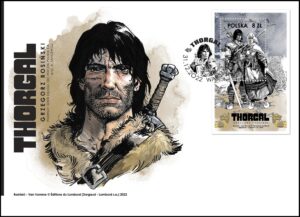
Znaczki wydrukowano techniką offsetową, na papierze fluorescencyjnym, w formacie 31,25 x 43 mm, format bloku: 54 x 86 mm, w nakładzie 100 000 sztuk. Z tej okazji została wydana również koperta FDC. Autor projektu znaczka: Agnieszka Sancewicz.

Chińskie znaki zodiaku
www.poczta-polska.pl
W dniu 23 stycznia 2023 roku został wprowadzony do obiegu znaczek pocztowy o wartości 4,60 zł emisji “Chińskie znaki zodiaku”. Bieżący rok jest wg chińskiego kalendarza rokiem królika, i to jego podobizna znajduje się na znaczku.
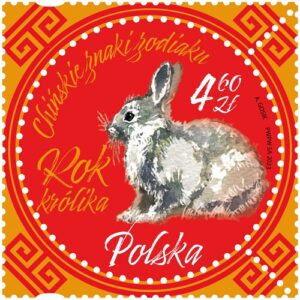
Znaczki wydrukowano techniką offsetową, na papierze fluorescencyjnym, w formacie 45 x 45 mm, w tym koło o średnicy 40 mm, w nakładzie 128 000 sztuk. Arkusz sprzedażny zawiera 8 sztuk znaczków. Z tej okazji została wydana koperta FDC. Autor projektu: Andrzej Gosik.


Odkryj Polskę –
Klasztor pobenedyktyński na Świętym Krzyżu
www.nbp.pl
Narodowy Bank Polski jest centralnym bankiem państwa odpowiadającym za politykę pieniężną i stabilność cen. Jego funkcje określa Konstytucja Rzeczypospolitej Polskiej i ustawa o NBP. NBP ma wyłączne prawo emisji pieniądza. Jako bank centralny nie prowadzi rachunków bankowych obywateli, nie przyjmuje od nich lokat, nie udziela kredytów. Prowadzi natomiast obsługę budżetu państwa, a także podmiotów sektora finansów publicznych. Gromadzi rezerwy walutowe państwa i zarządza nimi. Pełni funkcję banku banków, tworząc warunki do działania systemu bankowego. Jest również jednym z najważniejszych ośrodków naukowo-analitycznych w dziedzinie ekonomii i rynków finansowych.
Emisja wartości kolekcjonerskich stanowi okazję do upamiętniania ważnych historycznych rocznic i postaci oraz do rozwijania zainteresowań polską kulturą, nauką i tradycją. 24 listopada 2022 roku Narodowy Bank Polski wprowadził do obiegu monetę okolicznościową o nominale 5 zł z serii „Odkryj Polskę” – „Klasztor pobenedyktyński na Świętym Krzyżu”.
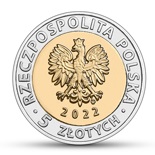
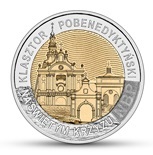
Nominał: 5 zł … stop: pierścień MN25, rdzeń CuAl6Ni2; stempel: zwykły; średnica: 24,00 mm; masa: 6,54 g; brzeg (bok): moletowany nieregularnie; na boku ośmiokrotnie powtórzony napis: NBP, co drugi odwrócony o 180 stopni, rozdzielony gwiazdkami; nakład: do 1 000 000 szt.; Projektant awersu: Dobrochna Surajewska; Projektant rewersu: Paweł Pietras; Emitent: NBP; Na zlecenie NBP monety wyprodukowała Mennica Polska S.A.
Położony we wschodniej części Łysogór, najwyższego pasma Gór Świętokrzyskich, pobenedyktyński klasztor na Świętym Krzyżu dzięki swojej wartości historycznej i religijnej jest zabytkiem o szczególnym znaczeniu dla polskiej kultury i narodowego dziedzictwa. Tradycja benedyktyńska utrwalona przez Jana Długosza przypisuje fundację opactwa Bolesławowi Chrobremu w 1006 r. Współcześni historycy przesuwają datę powstania klasztoru na pierwszą połowę XII w., za czasów księcia Bolesława Krzywoustego. Na początku XIV w. opactwu zostały ofiarowane relikwie Drzewa Krzyża Świętego, co uczyniło to miejsce najważniejszym i najstarszym sanktuarium na ziemiach polskich, a także celem pielgrzymek zarówno polskich władców, jak i prostego ludu.
Łysogórskie opactwo przez wieki krzewiło kulturę duchową i intelektualną, szczycąc się jedną z najwspanialszych w Polsce bibliotek. To właśnie w przechowywanym tu XV-wiecznym kodeksie odkryto słynne „Kazania świętokrzyskie”, najstarszy zabytek piśmiennictwa polskiego. Świętokrzyscy benedyktyni prowadzili ożywioną działalność duszpasterską, rozwijali szkolnictwo, zajmowali się ziołolecznictwem. Wspaniałe dzieje opactwa przerwała jego kasata w 1819 r. Bezcenne zbiory i wyposażenie wywieziono i rozgrabiono, zaś budynki klasztorne zaczęły popadać w ruinę. Kolejnym ciosem dla Świętego Krzyża było utworzenie w jego murach przez rosyjskiego zaborcę ciężkiego więzienia. Przetrwało ono do czasów II Rzeczypospolitej.
W 1936 r. na Święty Krzyż przybyli misjonarze oblaci Maryi Niepokalanej, którzy podjęli trud odbudowy kościoła i pomieszczeń klasztornych. Prace przerwał wybuch II wojny światowej. Klasztor został zbombardowany, zaś w zabudowaniach więziennych niemiecki okupant urządził obóz jeniecki. Po wojnie dzieło odbudowy podjęto na nowo. Dziś Sanktuarium Relikwii Drzewa Krzyża Świętego przyciąga rocznie niemal 300 tysięcy pielgrzymów i turystów. Oprócz działalności duszpasterskiej w jego murach są organizowane sympozja naukowe, koncerty, wystawy okolicznościowe i spotkania. W 2017 r. miejsce to zostało uhonorowane zaszczytnym tytułem „Pomnika Historii”.Informacja: o. Krzysztof Jamrozy OMI.

Discover Poland – The Former Benedictine Monastery
on Święty Krzyż Mountain
www.nbp.pl
Narodowy Bank Polski is the central bank of the State, responsible for its monetary policy and price stability. The Bank’s functions are described in the Constitution of the Republic of Poland and the Act on NBP. NBP holds the exclusive right to issue the currency of the Republic of Poland. As the central bank, it does not provide accounts for the general public, accept deposits from or extend loans to individuals. It acts as a banker to the State budget and public sector entities. NBP also holds and manages the foreign exchange reserves of the State. Finally, it functions as a banker to banks, creating conditions for the operation of the Polish banking system. Narodowy Bank Polski is one of the most important research and analytical centres in the fields of economics and financial markets.
Issuing collector items is an occasion to commemorate important historic figures and anniversaries, as well as to develop the interest of the public in Polish culture, science and tradition. On 24 November 2022, Narodowy Bank Polski issued into circulation a commemorative coin of the series “Discover Poland” – “The Former Benedictine Monastery on Święty Krzyż Mount”, with a face value of 5 złoty.


Face value: 5 zł … Alloy: ring MN25, core CuAl6Ni2; Finish: standard; Diameter: 24.00 mm; Weight: 6.54 g; Edge (side): irregularly milled; on the edge: the inscription, NBP, repeated eight times, every second one inverted by 180 degrees, separated by stars; Mintage: up to 1,000,000 pcs; Obverse designer: Dobrochna Surajewska; Reverse designer: Paweł Pietras; Issuer: NBP; The coins, commissioned by NBP, were struck by Mennica Polska S.A.
Situated in the eastern part of the Łysogóry Mountains, the highest range of the Świętokrzyskie Mountains, the former Benedictine monastery on Święty Krzyż (literally Holy Cross) Mount, thanks to its historical and religious value, is a monument of particular significance for Polish culture and national heritage. Benedictine tradition, as recorded by Polish chronicler Jan Długosz, attributes the foundation of the abbey to Boleslaus the Brave in 1006. Contemporary historians postpone the date of the monastery’s foundation to the first half of the 12th century, during the reign of Prince Boleslaus the Wrymouth. At the beginning of the 14th century, the relics of the Holy Cross were donated to the abbey, making this place the most important and oldest sanctuary on Polish soil, as well as a pilgrimage destination for both Polish rulers and common people. For centuries, the Święty Krzyż Abbey has promoted spiritual and intellectual culture, priding itself on one of the most magnificent libraries in Poland.
It was in a 15th-century codex kept here that the famous Kazania Świętokrzyskie [The Holy Cross Sermons], the oldest relic of Polish writing, was discovered. The Benedictines of Święty Krzyż Mount led a lively pastoral activity, developed education and were involved in herbal medicine. The glorious history of the abbey was interrupted by its dissolution in 1819. The priceless collections and equipment were taken away and looted, and the monastery buildings began to fall into ruin. Another blow to the abbey was the establishment of a strict regime prison within its walls by Russia, one of the partitioning powers. It survived until the Second Republic of Poland.
In 1936, the Oblate Missionaries of Mary Immaculate arrived at Święty Krzyż and undertook the effort to rebuild the church and the monastery premises. The work was interrupted by the outbreak of the Second World War. The monastery was bombed and the German occupiers set up a prisonerof-war camp in the prison buildings. After the war, the work of reconstruction was restarted. Today, the Sanctuary of the Relics of the Holy Cross attracts almost 300,000 pilgrims and tourists annually. In addition to pastoral activities, its walls host scientific symposia, concerts, occasional exhibitions and meetings. In 2017, the site was awarded the honourable title of ‘Monument of History’. Info: Fr. Krzysztof Jamrozy OMI.

Skarby Stanisława Augusta – August II Mocny
www.nbp.pl
Skarby Stanisława Augusta Wyjątkowa seria złotych i srebrnych monet kolekcjonerskich o nominałach 500 zł i 50 zł – „Skarby Stanisława Augusta” – odwzorowuje słynną osiemnastowieczną serię medalierską z wizerunkami królów Polski wykonaną na zlecenie Stanisława Augusta Poniatowskiego. Królewskie medale powstawały w mennicy warszawskiej w latach 1791–1797/1798. Ich twórcami byli dwaj wybitni medalierzy Jan Filip Holzhaeusser i Jan Jakub Reichel. Medale były wzorowane na portretach namalowanych w latach 1768–1771 przez Marcella Bacciarellego do Pokoju Marmurowego w Zamku Królewskim w Warszawie. Monety emitowane przez Narodowy Bank Polski są wiernymi replikami medali, zachowują średnicę i wysokość reliefu oryginałów. Dotyczy to portretów królewskich prezentowanych na rewersach monet. Odwrotne strony medali z życiorysami królów, umieszczone na awersach monet, zostały pomniejszone, ponieważ towarzyszy im otok z nazwą państwa, godłem Rzeczypospolitej, nominałem oraz rokiem emisji. Życiorysy monarchów, jak również napisy na awersach medali towarzyszące portretom władców, zredagowane są po łacinie. Ostatecznej redakcji tych tekstów dokonał zapewne sam król Stanisław August. Imiona monarchów w języku polskim umieszczone zostały na boku monet; tamże znajduje się nazwa serii „Skarby Stanisława Augusta”.
Poczet królów polskich wykonany na zlecenie Stanisława Augusta Poniatowskiego składał się z wizerunków 23 monarchów. Był tu o jeden portret królewski więcej niż na obrazach Bacciarellego, którego cykl obejmuje 22 obrazy. Dodatkowy portret Stanisława Leszczyńskiego, umieszczony na medalu, powstał najprawdopodobniej na podstawie obrazu Jana Bogumiła Plerscha. Obie serie, malarska i medalierska, zaczynają się od Bolesława Chrobrego, a kończą wizerunkiem Augusta III Sasa. W Pokoju Marmurowym od XVIII wieku naczelne miejsce zajmuje jednak kilkakrotnie większy od pozostałych królewskich portretów wizerunek Stanisława Augusta w pełnej postaci, w stroju koronacyjnym. Zapewne więc i serię medalierską zamykać miał medal z wizerunkiem aktualnie panującego monarchy. Abdykacja, emigracja i rychła śmierć króla w początku 1798 r. uniemożliwiły realizację tego zamierzenia. Seria monet „Skarby Stanisława Augusta” obejmuje 24 wizerunki monarchów – 23 z oryginalnej serii królewskiej oraz portret Stanisława Augusta, odtworzony według medali z epoki. Tak jak w XVIII wieku medale, monety będą bite w złocie i w srebrze. Informacja: Tomasz Bylicki, starszy kustosz Muzeum Historyczne m.st. Warszawy.
August II Mocny (1697−1706, 1709−1733) … Dwudziesta pierwsza moneta serii przedstawia Augusta II zwanego Mocnym, z dynastii Wettinów, od 1694 r. elektora saskiego (jako Fryderyk August I), w Polsce obranego na króla 27 czerwca i koronowanego 15 września 1697 r. Jako elektor przystąpił w 1700 r. do wojny północnej i w wyniku klęsk w 1706 r. zrzekł się korony na rzecz Stanisława Leszczyńskiego, popieranego przez Szwedów. Po klęsce Karola XII pod Połtawą w 1709 r. powrócił na tron Polski przy poparciu Rosji. Na rewersie monety widnieje przeniesione z medalu popiersie króla (według obrazu Marcella Bacciarellego) w lewym profilu, w peruce z harcapem, w halsbandzie z małym żabotem spiętym agrafą, w kirysie, we fraku z szamerowanymi wyłogami, z gwiazdą i wstęgą Orderu Orła Białego oraz Orderem Złotego Runa na wstędze. Na awersie monety czytamy tekst z rewersu medalu (w tłumaczeniu): Wybrany Roku Pańskiego 1697 dnia 27 czerwca, koronowany dnia 15 września.
Kamieniec Podolski zdobyty przez Turków odzyskał pokojem karłowickim, wygnany z królestwa przez Karola XII szwedzkiego, powrócił do kraju Roku Pańskiego 1709. Umarł w Warszawie Roku Pańskiego 1733, mając lat 63, w 36 roku panowania, dnia 1 lutego. Fryderyk August I, syn elektora saskiego Jana Jerzego III i Anny Zofii Oldenburg, urodził się w 1670 r. w Dreźnie. Zdobył wykształcenie dworskie i odbył dwuletnią Grand Tour. Dla objęcia tronu polskiego dokonał konwersji na katolicyzm i przyjął imię August II. Jego żona Krystyna Eberhardyna von Brandenburg-Bayreuth pozostała przy wyznaniu luterańskim i dlatego nie została koronowana. Miał jednego legitymowanego syna Fryderyka Augusta II, późniejszego króla polskiego Augusta III. Hulaszczy tryb życia Augusta II i liczne miłostki (m.in. z hrabiną Cosel) zaowocowały kilkorgiem pozamałżeńskich dzieci.
August II był zwolennikiem władzy absolutnej, jaką sprawował w Saksonii, co powodowało silne konflikty z polską szlachtą, zawiązującą antykrólewskie konfederacje. Sojusznika znalazł w carze Piotrze I, który aż do tzw. Sejmu Niemego (1717) utrzymywał w Polsce swe wojska. W Saksonii August II przeprowadził wiele reform politycznych i gospodarczych, natomiast w Polsce trwał kryzys władzy, przez co kraj utracił status silnego państwa. Król pozostawił po sobie m.in. Pałac Saski w Warszawie, będący częścią założenia urbanistycznego zwanego Osią Saską. Ustanowił Order Orła Białego, do dzisiaj najwyższe polskie odznaczenie. Zmarł w Warszawie w 1733 r. Został pochowany na Wawelu, wnętrzności umieszczono w kościele Kapucynów w Warszawie, zaś serce złożono w kościele katolickim w Dreźnie. Informacja: Marta Męclewska.
Nominał 500 zł … metal: Au 999,9/1000; stempel: zwykły; średnica: 45 mm; masa: 62,2 g; napis na obrzeżu: SKARBY STANISŁAWA AUGUSTA * AUGUST II MOCNY *; nakład: do 600 szt.; Projektant rewersu – Anna Wątróbska-Wdowiarska; Projektant awersu oraz napisów na rewersie – Robert Kotowicz; Na zlecenie NBP monetę wyprodukowała Mennica Polska S.A.; Emisja: 1 grudnia 2022 r.
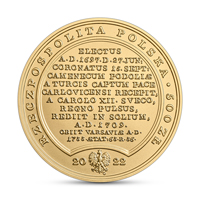

Wybrany Roku Pańskiego 1697 dnia 27 czerwca, koronowany dnia 15 września. Kamieniec Podolski zdobyty przez Turków odzyskał pokojem karłowickim, wygnany z królestwa przez Karola XII szwedzkiego, powrócił do kraju Roku Pańskiego 1709. Umarł w Warszawie Roku Pańskiego 1733, mając lat 63, w 36 roku panowania, dnia 1 lutego.

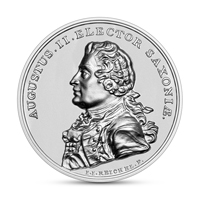
Nominał 50 zł … metal: Ag 999/1000; stempel: zwykły; średnica: 45 mm; masa: 62,2 g; napis na obrzeżu: SKARBY STANISŁAWA AUGUSTA * AUGUST II MOCNY *; nakład: do 6000 szt; Projektant rewersu – Anna Wątróbska-Wdowiarska; Projektant awersu oraz napisów na rewersie – Robert Kotowicz; Na zlecenie NBP monetę wyprodukowała Mennica Polska S.A.; Emisja: 1 grudnia 2022 r.
Narodowy Bank Polski jest centralnym bankiem państwa odpowiadającym za politykę pieniężną i stabilność cen. Jego funkcje określa Konstytucja Rzeczypospolitej Polskiej i Ustawa o NBP. NBP ma wyłączne prawo emisji pieniądza. Jako bank centralny nie prowadzi rachunków bankowych obywateli, nie przyjmuje od nich lokat ani nie udziela kredytów. Prowadzi natomiast obsługę budżetu państwa, a także podmiotów sektora finansów publicznych. Gromadzi rezerwy walutowe państwa i zarządza nimi. Pełni funkcję banku banków, tworząc warunki do działania systemu bankowego. Jest również jednym z najważniejszych ośrodków naukowo-analitycznych w dziedzinie ekonomii i rynków finansowych. Emisja wartości kolekcjonerskich stanowi okazję do upamiętnienia ważnych historycznych rocznic i postaci oraz do rozwijania zainteresowań polską kulturą, nauką i tradycją.

Treasures of Stanislaw August – Augustus II the Strong
www.nbp.pl
Treasures of Stanisław August … The unique series of gold and silver collector coins with the face values of 500 zloty and 50 zloty – “TREASURES OF STANISŁAW AUGUST” – replicates the famous 18th century medallic series with the images of the kings of Poland, which was struck on the order of Stanisław August Poniatowski. The royal medals, designed by two outstanding medallists: Jan Filip Holzhaeusser and Jan Jakub Reichel, were struck at the Warsaw mint in the years 1791–1797/1798. The design of the medals was based on portraits painted between 1768 and 1771 by Marcello Bacciarelli for the Marble Room at the Royal Castle in Warsaw.
The coins issued by Narodowy Bank Polski are faithful replicas of the medals, preserving the diameter and height of relief of the originals. This applies to the portraits of the kings on the reverses. The obverses of the coins feature the reverses of the medals with biographies of the monarchs. The reverses of the medals have been reduced in size because they are accompanied by the name of the state along the rim, the image of the state emblem, the face value and the year of issue of the coins. The biographies of the monarchs and the inscriptions on the obverses of the medals accompanying the royal portraits are in Latin. The final text editing was most likely done by King Stanisław August himself.
The names of the monarchs in Polish are presented on the sides of the coins, along with the name of the series “Treasures of Stanisław August”. The gallery of portraits of Polish kings, painted on the order of Stanisław August Poniatowski, consisted of images of 23 monarchs. It included one royal portrait more than Bacciarelli’s series of 22 paintings. The additional portrait of Stanisław Leszczyński – featured on the medal – was most probably modelled on a painting by Jan Bogumił Plersch. Both series, the paintings and the medals, begin with the image of Bolesław Chrobry and end with the portrait of August III. Since the 18th century, the principal place in the Marble Room has belonged to the portrait of the full length figure of Stanisław August in his coronation robes. The painting is several times larger than other portraits. It is therefore probable that the medallic series would have finished with a medal presenting the image of the ruling monarch. However, these plans were thwarted by the king’s abdication, emigration and early death at the beginning of 1798. The series of coins “Treasures of Stanisław August” consists of 24 portraits of monarchs – of which 23 have been modelled on the royal series plus a portrait of Stanisław August based on the medals from the period. The series will be struck in silver and gold, as was the practice in the 18th century. Info: Tomasz Bylicki, senior curator Historical Museum of Warsaw.
Augustus II the Strong (1697−1706, 1709−1733) … The twenty first coin of the series shows Augustus II the Strong of the Wettin dynasty, Elector of Saxony from 1694 (as Frederick Augustus I), elected King of Poland on 27 June 1697 and crowned on 15 September 1697. As an elector he engaged in 1700 in the Great Northern War and as a result of military defeat in 1706 yielded the crown over to Stanisław Leszczyński, who was supported by Sweden. Following the defeat of King Charles XII in the battle of Poltava in 1709, Augustus regained the Polish throne with the support of Russia. The reverse of the coin features a bust of the king transferred from a medal (according to a painting by Marcello Bacciarelli), with the profile facing left, in a wig with a queue, wearing a stock tie with a small jabot fastened with a pin, dressed in a cuirass and a tailcoat with frogged lapels adorned with the star and ribbon of the Order of the White Eagle, and the Order of the Golden Fleece on a ribbon. On the obverse of the coin, the text from the reverse of the medal (in translation) reads: Elected on the 27th day of June Anno Domini 1697, crowned on the 15th day of September. Under the Treaty of Karlowitz he regained Kamieniec Podolski, which had been captured by the Turks; driven out of the kingdom by the Swedish king Charles XII, he returned to the homeland Anno Domini 1709. He died in Warsaw on the 1st day of February Anno Domini 1733, at the age of 63, in the 36th year of his reign.
Frederick Augustus I, a son of Elector of Saxony Johann Georg III and Anne Sophie of Denmark, was born in 1670 in Dresden. He received a courtly education and went on a two-year grand tour. To assume the Polish throne, he converted to Catholicism and took the name of Augustus II. His wife Christiane Eberhardine of Brandenburg Bayreuth would not renounce her Lutheran faith, therefore she was not crowned queen. Augustus II had a single legitimate son, Frederick Augustus II, who later became Polish king Augustus III. Augustus II led a reveller’s lifestyle and had numerous love affairs (with Countess of Cosel, among others), begetting several illegitimate children. Augustus II was a supporter of absolute power, which he wielded in Saxony, sparking strong conflicts with the Polish nobility, which established antiroyal confederations. The king found an ally in Tsar Peter I, who maintained his troops in Poland until as late as 1717, i.e. until the so-called Silent Sejm. While in Saxony Augustus II carried out numerous political and economic reforms, Poland was engulfed in a power crisis and the country lost the status of a strong state. The king’s legacy includes the Saxon Palace in Warsaw, a part of the urban planning concept known as the Saxon Axis. He founded the Order of the White Eagle, the highest Polish decoration until today. He died in Warsaw in 1733. He was buried in Wawel, but his entrails are interred in the Capuchin Friars Church in Warsaw, and his heart in the Catholic Church in Dresden. Info: Marta Męclewska.
Face value: 500 zł … metal: Au 999.9/1000; finish: standard; diameter: 45 mm; weight: 62.2 g; On the edge, the inscription: SKARBY STANISŁAWA AUGUSTA * AUGUST II MOCNY *; mintage: up to 600 pcs; Designer: reverse – Anna Wątróbska-Wdowiarska; Obverse and inscriptions on the reverse – Robert Kotowicz; Producer: Mennica Polska S.A. commissioned by NBP; Date of issue: 1 December 2022.


Elected on the 27th day of June Anno Domini 1697, crowned on the 15th day of September. Under the Treaty of Karlowitz he regained Kamieniec Podolski, which had been captured by the Turks; driven out of the kingdom by the Swedish king Charles XII, he returned to the homeland Anno Domini 1709. He died in Warsaw on the 1st day of February Anno Domini 1733, at the age of 63, in the 36th year of his reign.


Face value: 50 zł … metal: Ag 999/1000; finish: standard; diameter: 45 mm; weight: 62.2 g; On the edge, the inscription: SKARBY STANISŁAWA AUGUSTA * AUGUST II MOCNY *; mintage: up to 6,000 pcs; Designer: reverse – Anna Wątróbska-Wdowiarska; Obverse and inscriptions on the reverse – Robert Kotowicz; Producer: Mennica Polska S.A. commissioned by NBP; Date of issue: 1 December 2022.
Narodowy Bank Polski is the central bank of the State, responsible for its monetary policy and price stability. The Bank’s functions are described in the Constitution of the Republic of Poland and the Act on NBP. NBP holds the exclusive right to issue the currency of the Republic of Poland. As the central bank, it does not provide accounts for the general public, accept deposits from or extend loans to individuals. It acts as a banker to the State budget and public sector entities. NBP also holds and manages the foreign exchange reserves of the State. Finally, it functions as a banker to banks, creating conditions for the operation of the Polish banking system. Narodowy Bank Polski is one of the most important research and analytical centres in the fields of economics and financial markets. Issuing collector items is an occasion to commemorate important historic figures and anniversaries, as well as to develop interest of the public in Polish culture, science, and tradition.


2022 Holiday Birds –
Cardinal: PermanentTM domestic rate stamps
www.canadapost.ca
Celebrate the holiday season with this booklet of 12 PermanentTM domestic rate Cardinal stamps from the Holiday Birds stamp issue. Many creatures in nature bring good tidings, especially birds such as northern cardinals. Their brilliant colours and visits to backyard feeders brighten the season. The cardinal, with its festive red colouring, can represent transformation or a pivotal point in one’s life and is a symbol of devotion, diversity and unity.
This holiday season three-stamp issue features colourful illustrations by Sandra Dionisi of three birds that overwinter in Canada. The first stamp features a cardinal (Permanent™ domestic rate), the second stamp features a blue jay (U.S. rate) and the third stamp features an evening grosbeak (international rate). This is the first stamp by Hambly & Woolley Inc. Stamp Value: Permanent™ domestic rate; Stamp Designer: Hambly & Woolley Inc.; Stamp Illustrator: Sandra Dionisi; Quantity Produced: 1,100,000; Issue Date: November 1, 2022.
2022 Holiday Birds – Grosbeak: International rate stamps – booklet of 6 … Celebrate the holiday season with this booklet of 6 International rate Grosbeak stamps from the Holiday Birds stamp issue. Stamp Value: $2.71 (international rate); Stamp Designer: Hambly & Woolley Inc.; Stamp Illustrator: Sandra Dionisi; Quantity Produced: 330,000; Issue Date: November 1, 2022.
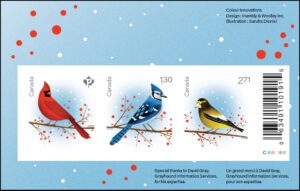
2022 Holiday Birds – Blue Jay : United States rate stamps – booklet of 6 … Celebrate the holiday season with this booklet of 6 United States rate Blue Jay stamps from the Holiday Birds stamp issue. Stamp Value: $1.30 (U.S. rate); Stamp Designer: Hambly & Woolley Inc.; Stamp Illustrator: Sandra Dionisi; Quantity Produced: 350,000; Issue Date: November 1, 2022.
2022 Holiday Birds: Souvenir sheet … Celebrate the holiday season with this souvenir sheet from the Holiday Birds stamp issue… This souvenir sheet features all three stamps from the Holiday Birds stamp issue. Many creatures in nature bring good tidings, especially birds such as northern cardinals, blue jays and evening grosbeaks that overwinter in Canada. Their brilliant colours and visits to backyard feeders brighten the season, and they, like other birds and animals, can bring us meaningful messages, which vary by culture or tradition. Stamp Designer: Hambly & Woolley Inc.; Stamp Illustrator: Sandra Dionisi; Quantity Produced: 50,000; Issue Date: November 1, 2022.
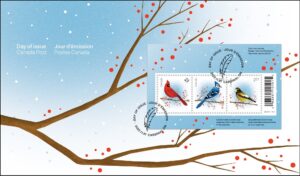
2022 Holiday Birds: Souvenir sheet Official First Day Cover … Celebrate the holiday season with this souvenir sheet Official First Day Cover from the Holiday Birds stamp issue. This OFDC is cancelled in Cardinal, Ontario. Stamp Value: Permanent™ domestic rate; Cancellation Site: Cardinal ON; Stamp Designer: Hambly & Woolley Inc.; Stamp Illustrator: Sandra Dionisi; Quantity Produced: 7,000; Issue Date: November 1, 2022.


Monique Mercure: PermanentTM domestic rate stamps
www.canadapost.ca
Take home this booklet of 6 PermanentTM domestic rate stamps honouring the life and career of francophone actress Monique Mercure. Canada Post has honoured many Canadian actors and performers – from Hollywood legends Fay Wray, Mary Pickford and Christopher Plummer to comedic stars such Marie Dressler, Jim Carrey and Catherine O’Hara. Mercure is in good company.
This stamp features an illustrated black-and-white portrait by Oriana Fenwick that captures Mercure’s striking beauty and expressive eyes, caught in a sidelong glance. The illustration is based on a photograph of Mercure taken in 1963 by Henri Paul (Radio-Canada Archives). The booklet cover features an illustration of Mercure by Oriana Fenwick based on a still from the 1977 movie J.A. Martin photographe (J.A. Martin Photographer, National Film Board of Canada). She is earing a wide-brimmed hat and looking thoughtfully into the distance. Known as Quebec’s grande dame of stage and screen, Monique Mercure (1930-2020) was one of Canada’s most admired and acclaimed francophone actresses. She was known for her fiery spirit, versatility and powerful performances. Mercure began acting as a struggling single mother in her late 20s. Her rise to fame was meteoric, and she went on to appear in more than 100 theatrical productions in North America and Europe, as well as dozens of movies and television series.
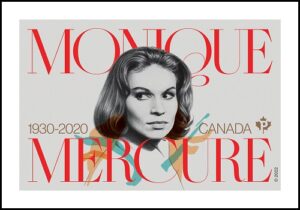
Mercure’s most memorable films include Mon oncle Antoine (1971), J.A. Martin photographe (1977) – which earned her Canada’s first Festival de Cannes award for best actress – Naked Lunch (1991) and The Red Violin (1998). She was also a regular in the TV dramas Providence (2005-11) and Mémoires vives (2013-16). A Companion of the Order of Canada and recipient of numerous prestigious awards and accolades over her 60-year career, Mercure also inspired a new generation of performers during her decade as director and then artistic director of the National Theatre School of Canada. Stamp Designer: Underline Studio; Stamp Illustrator: Oriana Fenwick; Stamp Value: Permanent™ domestic rate; Quantity Produced: 150,000; Issue Date: November 14, 2022.
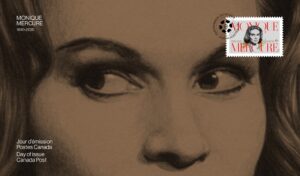
Monique Mercure: Official First Day Cover … Take home this Official First Day Cover honouring the life and career of francophone actress Monique Mercure. This Official First Day Cover features a close-up of the stamp illustration that shows only the upper half of Mercure’s face, from her eyes to her nose. The cancel is a line drawing of a film reel. The issue date is November 14 (Mercure’s date of birth), and the cancellation location is Montréal, Quebec (Mercure’s place of birth). Cancellation Site: Montréal QC; Stamp Designer: Underline Studio; Stamp Illustrator: Oriana Fenwick; Stamp Value: Permanent™ domestic rate; Quantity Produced: 7,000; Issue Date: November 14, 2022.
Monique Mercure: PermanentTM domestic rate stamps – pane of 6 … Take home this pane of 6 Permanent TM domestic rate stamps honouring the life and career of francophone actress Monique Mercure. The background of the six-stamp pane features a head-and-shoulders illustration by Oriana Fenwick of Mercure with an intense look on her face, seemingly engaged in conversation. The image is based on a still from the movie This Is No Time for Romance (National Film Board of Canada). Stamp Designer: Underline Studio; Stamp Illustrator: Oriana Fenwick; Stamp Value: Permanent™ domestic rate; Quantity Produced: 20,000; Issue Date: November 14, 2022.


2022 …$20 Fine Silver Coin –
Relics of New France: Louis XIV 30 Deniers
www.mint.ca
This modern tribute revisits the 1711 Louis XIV 30 deniers featured on the 2021 Relics of New France gold piece and shows you the other side of the coin: the obverse! The monogram of the long-reigning King Louis XIV has been faithfully re-created on a 5 oz. 99.99% fine silver coin, which is presented alongside a genuine 30-deniers coin that instantly evokes images of life in New France. Own a replica AND a relic! This two-coin set is an extraordinary tribute to an important coin in Canadian history.
A genuine 30 deniers … Your fine silver coin comes with a genuine Louis XIV 30 deniers coin sealed in an authenticated coin slab. Both coins are enclosed in a black clamshell—perfect for side-by-side viewing. New yet “aged” … Modern engraving techniques mimic the effects of time without interfering with the proof finish.
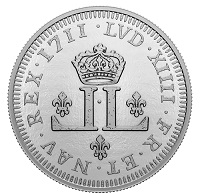
Face value: 20 dollars … Composition: 99.99% Pure Silver;
Mintage: 1,250; Finish: Proof; Weight: 157.6 g;
Diameter: 65.25 mm; Edge: Serrated; Artist: Original design
by Norbert Roettiers (reverse); Susanna Blunt (obverse);
Packaging: Black clamshell with black beauty box.
DID YOU KNOW? … *** Coin shortages were a persistent problem in New France—many of the coins supplied by France were shipped back as payment for European goods and supplies, so they didn’t remain in the colony. In September 1709, King Louis XIV authorized two new denominations, 15 deniers and 30 deniers, which were struck between 1709 and 1713 at the Lyon and Metz mints. They were made in a billon alloy of 20% silver and 80% copper in an effort to stretch France’s limited silver supply. But the deniers’ low silver content made them unpopular in France; many ended up in New France, where they were never officially withdrawn from circulation, even after Canada was ceded to the British. *** Your coin’s reverse re-creates the Louis XIV 30 deniers obverse design by engraver Norbert Roettiers (1665-1727). It features the crowned doubled monogram of King Louis XIV of France flanked by three fleurs-de-lis, along with the Latin inscription “LVD · XIIII · FR · ET · NAV · REX · 1711” (“Louis XIV, by the grace of God, king of France and Navarre, 1711”). The obverse features the effigy of Her Majesty Queen Elizabeth II by Susanna Blunt.
Matthew Bowen, Engraver … “This was a rare opportunity to replicate an 18th century French coin, and I’m privileged to have sculpted this tribute to the Louis XIV 30 deniers coin. We increased the size of this coin to 65.25 mm, which gave me a greater challenge of working on the master die. We also focused on the obverse, which is highly unusual for the Royal Canadian Mint, so I was doubly honoured to work on this unique coin.”

2022 … Pure Silver Coin –
10th Anniversary of the Last Penny
www.mint.ca
Canada’s penny returns… as a 5 oz. fine silver coin! To mark the 10th Anniversary of the last Canadian one-cent circulation coin ever minted, we brought back G. E. Kruger Gray’s iconic maple leaf twig design and reproduced it on a bigger scale – and in 99.99% pure silver. With its 65 mm diameter, this limited-edition tribute offers you an enlarged view of all those familiar details. And there’s a twist: a reproduction of the last penny struck in 2012 has been incorporated into this coin’s reverse, where it forms the “0” in the year “2022”.
A classic design … A fixture on Canada’s penny since its first appearance in 1937, G. E. Kruger Gray’s maple leaf twig is twice featured on this coin’s reverse. A coin re-created on a coin … A 2012 one-cent coin—the last of Canada’s pennies—forms the “0” in the year “2022.”
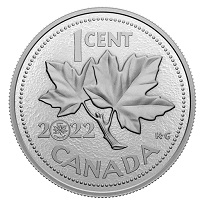
Face value: 1-cent … Composition: 99.99% Pure Silver;
Mintage: 1,500; Finish: Proof; Weight: 157.6 g;
Diameter: 65.25 mm; Edge: Serrated;
Artist: G. E. Kruger Gray (reverse); Susanna Blunt (obverse);
Packaging: Black clamshell with black beauty box.
DID YOU KNOW? … ***Roughly 35 billion Canadian one-cent coins were minted between 1908—our first year of operations as the Ottawa branch of the Royal Mint—and 2012, when the last penny was struck at our high-tech facility in Winnipeg, Manitoba. ***Your coin’s reverse is an enlarged version of G. E. Kruger Gray’s iconic maple leaf twig design, as seen on Canadian one-cent circulation coins issued from 1937 to 2012 (with the exception of 1967). The design features two upright, five-lobed maple leaves attached to a small twig. A reproduction of the last penny struck in 2012 stands in for the number “0” in the year “2022”. The obverse features the effigy of Her Majesty Queen Elizabeth II by Susanna Blunt.

2022 … 1-cent Five Kilogram Pure Silver Coin –
10th Anniversary of the Last Penny
www.mint.ca
Our oversized ode to Canada’s last penny… This year (2022) marks the 10TH anniversary of Canada’s last one-cent circulation coin, the last one struck before Canadians bade farewell to the penny. To commemorate the anniversary, and to honour the coin’s 154-year history, G. E. Kruger Gray’s beloved maple leaf twig design has been brought back to life and immortalized in five kilograms of 99.99% pure silver. With its impressive diameter of 180 millimetres, this limited-edition piece is the largest Canadian one-cent coin ever minted. It’s so large, we even incorporated a life-sized reproduction of the 2012 one-cent design into this coin’s reverse, where its round shape forms the “0” in the year “2022”.
A classic returns … A fixture on the penny since its first appearance in 1937, G. E. Kruger Gray’s maple leaf twig is twice featured on this coin’s reverse. A penny within a penny … Sized like a real penny, the 2012 one-cent coin design forms the “0” in the year “2022”. It’s a unique way of bridging the past and present! Luxury from start to finish … Housed in our finest wooden collector case, your 5 kg fine silver coin comes with a special booklet certificate that includes the story of Canada’s one-cent coin (1858-2012).
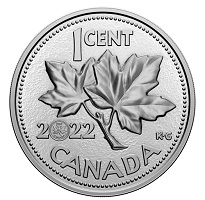
Face value: 1-cent … Composition: 99.99% Pure Silver;
Mintage: 150; Finish: Proof; Weight: 5000 g;
Diameter: 180 mm; Edge: Serrated;
Artist: G. E. Kruger Gray (reverse); Susanna Blunt (obverse);
Packaging: Wood case with black beauty box.
DID YOU KNOW? … *** Roughly 35 billion Canadian one-cent coins were minted between 1908—our first year of operations as the Ottawa branch of the Royal Mint—and 2012, when the last penny was struck at our high-tech facility in Winnipeg, Manitoba.
Your 5 kg fine silver coin’s reverse features a large-scale reproduction of G. E. Kruger Gray’s iconic maple leaf twig design, as seen on Canadian one-cent circulation coins issued from 1937 to 2012 (with the exception of 1967). The nature-inspired image features two upright, five-lobed maple leaves attached to a small twig. To commemorate the 10TH anniversary of Canada’s last penny, a life-sized reproduction of the 2012 one-cent coin design forms the number “0” in the year “2022”. The obverse features the effigy of Her Majesty Queen Elizabeth II by Susanna Blunt.


2022 … $1 … 175th Anniversary of the Birth of
Alexander Graham Bell Colourized Special Wrap Roll
www.mint.ca
The 175th Anniversary of the Birth of Alexander Graham Bell commemorative one-dollar coin honours his contributions and achievements, including a record-setting hydrofoil and the first powered aircraft to fly in Canada. Both the HD-4 and the Silver Dart made history on Nova Scotia’s Bras d’Or Lake, which is represented by blue waves on the 25 coins contained in each Colourized Special Wrap Roll.
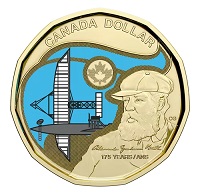
Face value: 1 dollar … Composition: Three-ply brass plated steel
with selective colour; Mintage: 17,000; Finish: Circulation;
Weight: 6.27 g; Diameter: 26.5 mm; Edge: plain;
Artist: Chris Gorey (reverse), Susanna Blunt (obverse).
DID YOU KNOW? … *** Alexander Graham Bell’s legacy of innovation encompasses so much more than the telephone. Problem solving and critical thinking are key to many STEM (Science, Technology, Engineering and Mathematics) fields, and Bell dedicated his life to solving challenges, whether it was sound transmission or aeronautics. *** Even in his later years, Bell remained committed to scientific exploration and discovery, and he continued to do innovative work in various fields—including aviation, which was his main interest in the 1890s and early 1900s. His Aerial Experiment Association (AEA), which was managed and funded by his wife Mabel, laid the groundwork for the development of aviation in Canada.
Designed by Canadian artist Chris Gorey, the coin’s reverse commemorates the 175th Anniversary (“175 YEARS/ANS”) of the birth of Alexander Graham Bell (1847-1922) by honouring his legacy of innovation. A reproduction of Bell’s signature is paired with a portrait of the inventor in his later years, when much of his scientific work was done at his estate in Baddeck, N.S. Those experiments are represented by schematic illustrations of the Silver Dart—the aircraft that achieved the first controlled, powered flight in Canada—and the record-setting HD-4 hydrofoil; both crafts made history on Bras d’Or Lake, represented by the waves that are highlighted in blue on the colourized coin. The obverse features the effigy of Her Majesty Queen Elizabeth II by Susanna Blunt. Personality rights of ALEXANDER GRAHAM BELL and usage rights for his signature, the Silver Dart and HD-4 Hydrofoil are used with the permission of The Alexander and Mabel Bell Legacy Foundation.

2022 … Commemorative Collector Keepsake Card –
175th Anniversary of the Birth of Alexander Graham Bell
www.mint.ca
Alexander Graham Bell changed the world with his inventions. Celebrate his many achievements and innovative spirit with our 2022 collectable coins—a tribute to an all-around visionary who constantly broke new and exciting ground.
The 175th Anniversary of the Birth of Alexander Graham Bell commemorative one-dollar coin honours his contributions and achievements, including a record-setting hydrofoil and the first powered aircraft to fly in Canada. Both crafts are depicted on the commemorative $1 coin, which is twice featured in this Keepsake Card: there’s the non-colour version, and one with blue waves representing Nova Scotia’s Bras d’Or Lake, where the HD-4 and the Silver Dart made history.
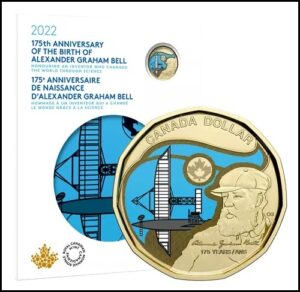
2022 … $1 … Circulation Coin 175th Anniversary of the Birth of Alexander Graham Bell (with Colour) … Composition: Three-ply brass plated steel with selective colour; Weight: 6.27 g; Diameter: 26.5 mm; Edge: Plain; Artist: Chris Gorey (reverse), Susanna Blunt (obverse).
2022 … $1 … Circulation Coin 175th Anniversary of the Birth of Alexander Graham Bell … Composition: Three-ply brass plated steel; Weight: 6.27 g; Diameter: 26.5 mm; Edge: Plain; Artist: Chris Gorey (reverse), Susanna Blunt (obverse).
2 dollars … Composition: Outer ring: Three-ply nickel finish plated steel. Inner core: Three-ply brass finish plated aluminium bronze; Weight: 6.99 g; Diameter: 28 mm; Edge: Interrupted serrations.
1 dollar … Composition: Three-ply brass plated steel; Weight: 6.27 g; Diameter: 26.5 mm; Edge: Plain.
25 cents … Composition: Three-ply nickel finish plated steel; Weight: 4.4 g; Diameter: 23.88 mm; Edge: Serrated.
10 cents … Composition: Three-ply nickel finish plated steel; Weight: 1.75 g; Diameter: 18.03 mm; Edge: Serrated.
5 cents … Composition: Three-ply nickel finish plated steel; Weight: 3.95 g; Diameter: 21.2 mm; Edge: Plain.
DID YOU KNOW? … *** Alexander Graham Bell’s legacy of innovation encompasses so much more than the telephone. Problem solving and critical thinking are key to many STEM (Science, Technology, Engineering and Mathematics) fields and Bell dedicated his life to solving challenges, whether it was sound transmission or aeronautics. *** Even in his later years, Bell remained committed to scientific exploration and discovery, and he continued to do innovative work in various fields—including aviation, which was his main interest in the 1890s and early 1900s. His Aerial Experiment Association (AEA), which was managed and funded by his wife Mabel, laid the groundwork for the development of aviation in Canada.
About the 175th Anniversary of the Birth of Alexander Graham Bell $1 coin … Designed by Canadian artist Chris Gorey, the coin’s reverse commemorates the 175th Anniversary (“175 YEARS/ANS”) of the birth of Alexander Graham Bell (1847-1922) by honouring his legacy of innovation. A reproduction of Bell’s signature is paired with a portrait of the inventor in his later years, when much of his scientific work was done at his estate in Baddeck, N.S. Those experiments are represented by schematic illustrations of the Silver Dart—the aircraft that achieved the first controlled, powered flight in Canada—and the record-setting HD-4 hydrofoil; both crafts made history on Bras d’Or Lake, represented by the waves that are highlighted in blue on the colourized coin. The obverse features the effigy of Her Majesty Queen Elizabeth II by Susanna Blunt.

2022 … Pure Gold Coin – 175th Anniversary
of the Birth of Alexander Graham Bell
www.mint.ca
From his estate in Baddeck, N.S., Alexander Graham Bell’s relentless drive for discovery bolstered this country’s spirit of innovation; and by partnering with Canadian innovators, Bell and his wife Mabel helped new ideas take flight, taking us faster and higher than ever before. This 99.99% pure gold coin’s reverse highlights Bell’s contributions to two scientific milestones achieved in Canada: the first powered aircraft to fly in Canada, the Silver Dart; and the record-setting HD-4 hydrofoil.

Face value: 200 dollars … Composition: 99.99% pure gold;
Mintage: 400; Finish: Proof; Weight: 31.16g;
Diameter: 30 mm; Edge: serrated;
Artist: Chris Gorey (reverse), Susanna Blunt (obverse).
Packaging: Black clamshell with red beauty box.
DID YOU KNOW? … *** His wife, Mabel Gardiner Hubbard Bell (1857-1923), did more than support her husband’s work—she was a key contributor to his many achievements. She recruited engineers to assist with Bell’s experiments in kites and flight; and in 1907, she became the first woman to form and finance an aviation company, the Aerial Experiment Association (AEA), which researched and built the Silver Dart (seen on your coin’s reverse). A keen horticulturalist, Mabel is also remembered as a leading community organizer who helped found the Baddeck Public Library, the first Canadian Montessori school, the first women’s club in Canada, and the country’s first home and school association. She also a tireless advocate for education, health, literacy and women’s suffrage.
Designed by Canadian artist Chris Gorey, the coin’s reverse commemorates the 175th Anniversary (“175 YEARS/ANS”) of the birth of Alexander Graham Bell (1847-1922) by honouring his legacy of innovation. A reproduction of Bell’s signature is paired with a portrait of the inventor in his later years, when much of his scientific work was done at his estate in Baddeck, N.S. Those experiments are represented by schematic illustrations of the Silver Dart—the aircraft that achieved the first controlled, powered flight in Canada—and the record-setting HD-4 hydrofoil; both crafts made history on Bras d’Or Lake, represented by the waves in the background. The obverse features the effigy of Her Majesty Queen Elizabeth II by Susanna Blunt.


The End of an Era:
The Legacy of Queen Elizabeth II endures on our coins
www.mint.ca www.canadapost.ca
The Mint joins our fellow Canadians, citizens of the Commonwealth, and others around the world in mourning the loss of Queen Elizabeth II. Over the course of a reign that has spanned more than seven decades, Queen Elizabeth II has played an integral role in the life of our nation. Canadians have enjoyed a close and enduring relationship with Queen Elizabeth II, exemplified by numerous visits, her ties to our fundamental institutions and remaining current with the progress of Canada as a diverse, modern nation.
This year, we celebrated the Platinum Jubilee of Queen Elizabeth II, marking her 70th anniversary on the Throne. She was Canada’s longest reigning monarch. It was another historic milestone in a life full of great achievements. The Royal Canadian Mint marked the occasion by issuing a two-coin set in collaboration with The Royal Mint, as well as a 1-oz pure platinum coin.
Many of her personal and official milestones have been commemorated on our coins, often featuring her likeness on both sides, since her portrait, or effigy, has graced their obverse, or heads side throughout her reign. Always facing right on the obverse, each of her portraits capture different eras of her reign, and there is plenty of history behind each one. Four different images of Queen Elizabeth II have graced the obverse of all Canadian circulation coins since 1953.
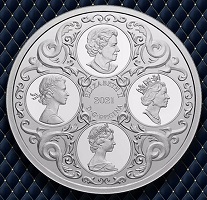
1953‑1964: The “laureate” effigy by Mary Gillick … Our first effigy of Queen Elizabeth II was selected by the Royal Mint Advisory Committee and designed by British sculptor Mary Gillick. It was used in the United Kingdom and across the Commonwealth. Youthful and uncrowned, this effigy remains popular with collectors. It is an elegantly simple design that captures the optimism of the time – the Second World War was over, and the newly crowned 27-year-old monarch brought youth and the promise of modernisation to a centuries-old institution. The effigy was used until 1964, with the inscription ELIZABETH II DEI GRATIA REGINA, meaning “Elizabeth II, by the grace of God, the Queen.”
1965-1989 – The “tiara” effigy by Arnold Machin … In 1964, the Royal Mint commissioned British sculptor Arnold Machin to design a contemporary royal portrait for its first decimal coins. His effigy is a regal head-and-shoulder bust that shows Queen Elizabeth II wearing the Girls of Great Britain and Ireland Tiara – a wedding gift from her grandmother, Queen Mary. In 1965, Canada became the first of the Commonwealth nations to adopt this effigy. It was accompanied by the inscription, ELIZABETH II D G REGINA, a shortened form of the original.
1990-2002 – The “diademed” effigy by Dora de Pédery-Hunt … The third likeness represents a break from tradition: it was the first effigy of a reigning monarch designed by a Canadian. Canadian-Hungarian artist Dora de Pédery-Hunt was commissioned to create an updated portrait exclusively for our coins. This third effigy was unveiled when Queen Elizabeth II was 64 years old. It shows her wearing a string of pearls and an imposing, sparkling headpiece known as the Diamond Diadem, also as the George IV State Diadem.
2003-present – The “uncrowned” effigy by Susanna Blunt … A more mature and informal portrait of Queen Elizabeth II has graced our coins since 2003. In 2002, several artists were invited to take part in a design competition for a new effigy. The winning submission came from Vancouver-based artist Susanna Blunt, whose portrait was introduced the following year to mark her Golden Jubilee. Simplicity makes this one stand out from the rest. Like her father, King George VI, Queen Elizabeth II chose to be portrayed without a crown, instead wearing a simple string of pearls and pearl stud earrings. The effigy exudes poise and strength, two qualities that have defined her reign. It’s a more modern representation of Queen Elizabeth II, an extraordinary person who dedicated her life to duty and to the service of the Commonwealth. A change in monarch does not require a wholesale replacement of our circulation coins and it will not disrupt daily commerce. The passing of Queen Elizabeth II marks the end of an era for our country, and we will develop a coin program that commemorates her historic reign. Source … Haxby, James A. Striking Impressions. The Royal Canadian Mint and Canadian Coinage, 1984.


2022 Pure Silver Coin – The Bigger Picture:
50-Cent Coin – Coat of Arms
www.mint.ca www.canadapost.ca
This is the Bigger Picture featured here, where the 50-cent coin is the centrepiece of an expanded design that represents the composition of Canada, and underscores how the provinces and territories – and their differences – strengthen the nation as a whole. The Coat of Arms design is synonymous with the 50-cent piece, but on this 5 oz. collectible, it shares the spotlight with all 13 provincial and territorial shields to provide a more complete representation Canada through its heraldic symbols.
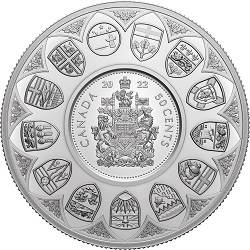
Face value: 50 Cent … Composition: 99.99% pure silver;
Mintage: 1,300; Finish: Proof; Weight: 157.6 g;
Diameter: 65.25 mm; Edge: serrated; Artist:
Cathy Bursey-Sabourin (reverse), Susanna Blunt (obverse).
Packaging: Black clamshell with black beauty box.
This coin’s reverse re-imagines the 50-cent circulation coin’s Canada Coat of Arms design as the centrepiece of an expanded representation of Canada through its heraldic symbols. The national armorial bearings are surrounded by 13 provincial and territorial shields (clockwise, from top): Ontario, Quebec, Nova Scotia, New Brunswick, Manitoba, Northwest Territories, British Columbia, Prince Edward Island, Yukon, Saskatchewan, Alberta, Newfoundland and Labrador, and Nunavut. The obverse features a maple leaf pattern and the effigy of Her Majesty Queen Elizabeth II by Susanna Blunt.


2023 … Pure Silver Coin –
Lunar Year of the Rabbit
www.mint.ca
Coin #2 in our fine silver Lunar Year series! The Rabbit is a cherished symbol of longevity, abundance and prosperity, and in Chinese folklore, it is the trusted companion of Chang’e, the goddess of the moon. People born in the Year of the Rabbit are kind, creative, sociable and peaceful; yet, behind that gentle smile lies great strength and a readiness to take swift action. The Rabbit is known for its attention to detail, and in a year associated with the Water element, it has the added ability to adapt to different situations in order to obtain the best possible outcome.
Intelligent, friendly and kind-hearted—celebrate the Rabbit(s) in your life with this 1 oz. pure silver Year of the Rabbit coin. Celebrate the Year of the Rabbit (2023) with the second coin in a 12-year Lunar Year series that began with the Year of the Tiger (2022). This charming keepsake is a great addition to your collection and the perfect way to honour a friend or loved one born in the Year of the Rabbit: 1927, 1939, 1951, 1963, 1975, 1987, 1999, 2011 and 2023. An ideal piece to mark a major milestone this year, whether it’s a graduation, wedding, or the arrival of a new family member born between January 22, 2023 and February 9, 2024. Part of a continuing minting tradition, your limited-edition coin has a special mintage of 18,888 to attract prosperity in the Year of the Rabbit (2023).
Inspired by folk art … Your coin’s reverse design features the same folk art style seen on the fine silver 2022 Lunar Year of the Tiger coin, which was inspired by the traditional Chinese cloth tiger toy. Red packaging … Your fine silver coin comes packaged in a red outer beauty box, evoking the Chinese New Year custom of gifting “lucky money” in a red envelope.

Face value: 15 dollars … Composition: 99.99% pure silver;
Mintage: 18,888; Finish: Proof; Weight: 31.39g;
Diameter: 38 mm; Edge: serrated;
Artist: Lily Kao (reverse), Susanna Blunt (obverse).
Packaging: Black clamshell with red beauty box.
Did You Know? … *** Years of the Rabbit: According to the Chinese zodiac, you’re a Rabbit if you were born in 1927, 1939, 1951, 1963, 1975, 1987, 1999, 2011 and 2023. *** The legend of the Jade (Moon) Rabbit: If you look up at the full moon, some of the shadows on the surface seem to form the outline of a rabbit with a mortar and pestle. There are a few different versions of the legend of the Jade or Moon Rabbit (also known as the Gold Rabbit), but according to one story, the rabbit was rewarded with immortality after it selflessly offered itself as food. The Jade Rabbit is said to live in Moon Palace with Chang’e, the goddess of the moon, whose origin story is associated with the annual Mid-Autumn Festival. The Jade Rabbit is often portrayed pounding the elixir of life while standing under a cinnamon (cassia) tree, which is thought to symbolize abundance and perpetual growth.
Inspired by the legend of the Jade (Moon) Rabbit, the reverse design by Canadian artist Lily Kao celebrates the Year of the Rabbit with a folk art-styled depiction of the Goddess of the Moon’s furry companion. The gentle and good-natured Rabbit is seen leaping over a new crescent moon that symbolizes new beginnings. The reverse also includes the word “CANADA”, the year “2023” and a face value of “15 DOLLARS”. The obverse features the effigy of Her Majesty Queen Elizabeth II by Susanna Blunt with a repeating scallop pattern.
LILY KAO, ARTST …The enchanting legend of the Jade Rabbit inspired this design. Here, the Rabbit is portrayed in a dynamic position, leaping over a moon crescent that symbolizes new beginnings and a new cycle. More than just cute and fluffy, the Jade Rabbit is a symbol of selflessness and devotion.”

2023 … $100 Pure Gold Coin –
Lunar Year of the Rabbit
www.mint.ca
Usher in prosperity and joyful beginnings with this pure gold Year of the Rabbit coin. It is a second $100 pure gold Lunar Year coin! The noble Rabbit is a symbol of longevity, abundance and prosperity. People born in the Year of the Rabbit are kind, creative, sociable and peaceful; yet, behind that gentle smile lies great strength and a readiness to take swift action. The Rabbit is known for its attention to detail, and in a year associated with the Water element, it has the added ability to adapt to different situations in order to obtain the best possible outcome.
Celebrate new beginnings in the Year of the Rabbit (2023) with this $100 pure gold Lunar New Year, with the second coin in an annual series that honours the 12 signs of the Chinese zodiac. A magnificent addition to any Lunar New Year or gold-themed collection, this coin is also the ideal piece to mark a major milestone this year, whether it’s a graduation, wedding or the arrival of a new family member born between January 22, 2023 and February 9, 2024.
Your lucky rabbit … Your coin features an intricate design filled with auspicious symbols to attract good fortune in 2023 and honours those born in the Year of the Rabbit: 1927, 1939, 1951, 1963, 1975, 1987, 1999, 2011 and 2023. Luxurious packaging … Your coin is encapsulated and elegantly presented in a luxurious red lacquered wooden case with a red beauty box, evoking the Chinese New Year custom of gifting “lucky money” in a red envelope.

Face value: 100 dollars … Composition: 99.99% pure gold;
Mintage: 1,888; Finish: Proof; Weight: 15.43g;
Diameter: 29 mm; Edge: serrated;
Artist: Aries Cheung (reverse), Susanna Blunt (obverse).
Packaging: Red wood case with red outer box.
Did You Know? … *** Years of the Rabbit: According to the Chinese zodiac, you’re a Rabbit if you were born in 1927, 1939, 1951, 1963, 1975, 1987, 1999, 2011 and 2023. *** The legend of the Jade (Moon) Rabbit: If you look up at the full moon, some of the shadows on the surface seem to form the outline of a rabbit with a mortar and pestle. There are a few different versions of the legend of the Jade or Moon Rabbit (also known as the Gold Rabbit), but according to one story, the rabbit was rewarded with immortality after it selflessly offered itself as food. The Jade Rabbit is said to live in Moon Palace with Chang’e, the goddess of the moon, whose origin story is associated with the annual Mid-Autumn Festival. The Jade Rabbit is often portrayed pounding the elixir of life while standing under a cinnamon (cassia) tree, which is thought to symbolize abundance and perpetual growth.
Inspired by the Chinese legend of the Jade Rabbit, the reverse design by artist Aries Cheung celebrates the Year of the Rabbit by showing the zodiac animal in a composed stance. Water is the dominant element in 2023 and it is represented by windmill-like wave patterns—the “wind” and “water” that is feng shui, which helps bring about more health and prosperity. In addition to these waves, wing-like motifs adorn the Rabbit’s ears and shoulders. Flowering plants and cinnamon leaves appear on one side of the Rabbit, while Moon Palace—the residence of Chang’e, the goddess of the moon—appears on the other side, where it is surrounded by auspicious cloud patterns. The reverse includes the word “CANADA”, the Chinese character for “Rabbit”, the year “2023” and the face value, “100 DOLLARS”. The obverse features the effigy of Her Majesty Queen Elizabeth II by Susanna Blunt.
ARIES CHEUNG, ARTIST … The element for 2023 being Water, this majestic Rabbit channels the energy of the feng shui (wind-water) wheels that bring us health, comfort and fortune.”


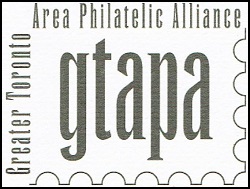
www.gtapa.org
The GTAPA is committed to promote and stimulate
the art of philately to all ages for fun,
culture, education, and friendship.




